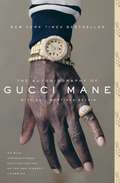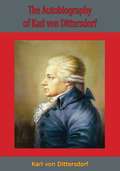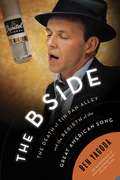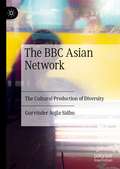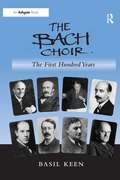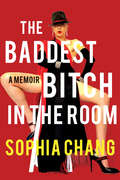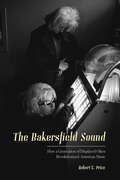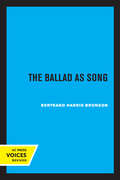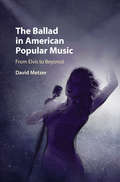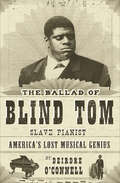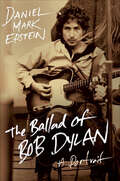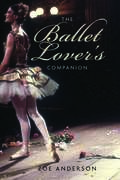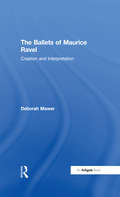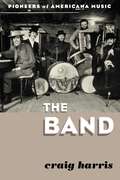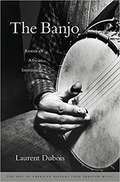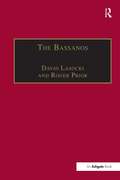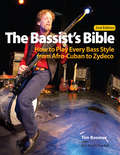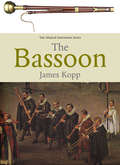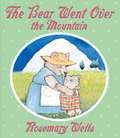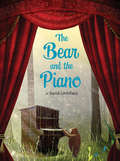- Table View
- List View
The Autobiography of Gucci Mane
by Gucci Mane Neil Martinez-BelkinThe New York Times bestselling memoir from the legendary Gucci Mane spares no detail in this &“cautionary tale that ends in triumph&” (GQ). For the first time Gucci Mane tells his extraordinary story in his own words. It is &“as wild, unpredictable, and fascinating as the man himself&” (Complex). The platinum-selling recording artist began writing his remarkable autobiography in a federal maximum security prison. Released in 2016, he emerged radically transformed. He was sober, smiling, focused, and positive—a far cry from the Gucci Mane of years past. A critically acclaimed classic, The Autobiography of Gucci Mane &“provides incredible insight into one of the most influential rappers of the last decade, detailing a volatile and fascinating life...By the end, every reader will have a greater understanding of Gucci Mane, the man and the musician&” (Pitchfork).
The Autobiography of Karl von Dittersdorf
by Karl Von DittersdorfThis autobiography of the famous Austrian composer, violinist and silvologist Karl Ditters von Dittersdorf was dictated from his death-bed, completed only two days before the artist’s death on 24 October 1799. First published in 1896, it represents a valuable as the record of an artist’s every-day life at the close of the 18th century.“Dittersdorf, the honest chronicler of his own failures and successes, should have his say in England as well as in Germany. If not ornate, he is true. Haydn’s imaginary talk, as given in George Sand’s ‘Consuelo,’ is hard to reconcile with the language of Haydn’s Diary. In this plain-spoken little volume we hear the very words uttered by men of genius, not those coined for them by others.”—A. D. Coleridge, Preface
The B Side
by Ben YagodaFrom an acclaimed cultural critic, a narrative and social history of the Great American Songwriting era. Everybody knows and loves the American Songbook. But it's a bit less widely understood that in about 1950, this stream of great songs more or less dried up. All of a sudden, what came over the radio wasn't Gershwin, Porter, and Berlin, but "Come on-a My House" and "How Much Is That Doggie in the Window?" Elvis and rock and roll arrived a few years later, and at that point the game was truly up. What happened, and why? In The B Side, acclaimed cultural historian Ben Yagoda answers those questions in a fascinating piece of detective work. Drawing on previously untapped archival sources and on scores of interviews--the voices include Randy Newman, Jimmy Webb, Linda Ronstadt, and Herb Alpert--the book illuminates broad musical trends through a series of intertwined stories. Among them are the battle between ASCAP and Broadcast Music, Inc.; the revolution in jazz after World War II; the impact of radio and then television; and the bitter, decades-long feud between Mitch Miller and Frank Sinatra. The B Side is about taste, and the particular economics and culture of songwriting, and the potential of popular art for greatness and beauty. It's destined to become a classic of American musical history.
The BBC Asian Network: The Cultural Production of Diversity
by Gurvinder Aujla-SidhuThis ground-breaking new book provides a unique, in-depth analysis of the BBC Asian Network, the BBC’s national ethnic-specific digital radio station in the UK. Gurvinder Aujla-Sidhu offers an insight into the internal production culture at the radio station, revealing the challenges minority ethnic producers faced as they struggled to create a cohesive and distinct 'community of listeners'. Besides the differences of opinion that emerged within the inter-generational British Asian staff over how to address the audience’s needs, the book also reveals the ways in which 'race' is managed by the BBC, and how the culture of managerialism permeates recruitment strategies, music playlists and mother tongue language programmes. In-depth interviews unveil how the BBC's 'gatekeeping' system limits the dissemination of original journalism about British Asian communities, through the marginalisation of the expertise of narratives created by the network's own minority ethnic journalists.
The Bach Choir: The First Hundred Years
by Basil KeenThis study of the Bach Choir provides a much-needed overview of one of the major choral societies in London. Dr Basil Keen examines the background that led to the formation of an ad hoc body to give the first performance in England of J.S. Bach's B minor Mass. The musical and organizational effects of a permanent choral society drawn from one social group are traced during the first twenty years, after such time the pressures of social change led to a complete review followed by a restructuring of the methods of recruitment and internal organization. The rebuilding of the choir at the opening of the twentieth century, the expansion of the repertoire, the upheaval resulting from the First World War and the impact of these events on preparation and performance, are all considered. The book is essentially structured around the tenure of successive Musical Directors: Otto Goldschmidt, Charles Villiers Stanford, Walford Davies, Hugh Allen, Ralph Vaughan Williams, Adrian Boult, Reginald Jacques and David Willcocks, since their varied tastes and interests inevitably had a decisive influence on policy. Keen draws upon previously unpublished material, including minutes and correspondence of the Bach Choir, interviews with relatives and descendants, and examination of family records and correspondence. To date, there has been no survey of a major London choir that encompasses the full history of the organization in context. In this study, Dr Basil Keen provides a thorough examination of the Bach Choir, including the response of the choir to social changes; the influence of conductors and officials; changes in musical taste; relationships with composers and composition; major national and international events; and the effect of these matters on organization and repertoire.
The Bach Family: Seven Generations of Creative Genius (Routledge Revivals)
by Karl Geiringer Irene GeiringerWhen this volume was originally published in 1954 it was the first complete history of the Bach family from the 16th Century miller Veit to Wilhelm Friedrich Ernst (1759-1845), Johann Sebastian’s grandson. The author views the family as a whole and shows the characteristic similarities in their artistic and human attitudes as well as the most significant divergences. Equal stress is laid on the discussion of the personalities, against the swiftly changing historical scene, and on the music, for which the author was able to use vast, hitherto inaccessible material. Apart from describing the fascinating phenomenon of this musical family, the author gives a history of musical thought in the last 300 years.
The Baddest Bitch in the Room: A Memoir
by Sophia ChangThe first Asian woman in hip-hop, Sophia Chang shares the inspiring story of her career in the music business, working with such acts as The Wu-Tang Clan and A Tribe Called Quest, her path to becoming an entrepreneur, and her candid accounts of marriage, motherhood, aging, desire, marginalization, and martial arts.Fearless and unpredictable, Sophia Chang prevailed in a male-dominated music industry to manage the biggest names in hip-hop and R&B. The daughter of Korean immigrants in predominantly white suburban Vancouver, Chang left for New York City, and soon became a powerful voice in music boardrooms at such record companies as Atlantic, Jive, and Universal Music Group.As an A&R rep, Chang met a Staten Island rapper named Prince Rakeem, now known as the RZA, founder of the Wu-Tang Clan, the most revered and influential rap group in hip-hop history. That union would send her on a transformational odyssey, leading her to a Shaolin monk who would become her partner, an enduring kung fu practice, two children, and a reckoning with what type woman she ultimately wanted to be.For decades, Chang helped remarkably talented men tell their stories. Now, with The Baddest Bitch In The Room, she is ready to tell her own story of marriage, motherhood, aging, desire, marginalization, and martial arts. This is an inspirational debut memoir by a woman of color who has had the audacity to be bold in the pursuit of her passions, despite what anyone—family, society, the dominant culture—have prescribed.
The Bagpipe: The History of a Musical Instrument (Routledge Library Editions: Scotland #9)
by Francis CollinsonOriginally published in 1975, and written by an authority on Scottish music, this book traces the evolution of the bagpipe whilst also narrating the fortunes of the ‘Great Highland Bagpipe’ itself. Exploring history and archaeology of civilizations as far removed from the Scottish Highlands as Egypt and Mesopotamia, Greece and Rome this book offers a unique full-length history of one of the world’s most interesting and ancient musical instruments. Appendices list the bagpipes of other countries and the materials used in the instrument’s manufacture as well as a comprehensive bibliography.
The Bakersfield Sound: How a Generation of Displaced Okies Revolutionized American Music
by Robert E. PriceAn immersive look at the country music sub-genre, from its 1950s origins to its heyday to the twenty-first century.In California’s Central Valley, two thousand miles away from Nashville’s country hit machine, the hard edge of the Bakersfield Sound transformed American music during the later half of the twentieth century. Fueled by the steel twang of electric guitars, explosive drumming, and powerfully aching lyrics, the Sound transformed hard times and desperation into chart-toppers. It vaulted displaced Oklahomans like Buck Owens and Merle Haggard to stardom, and even today the Sound’s influence on country music is still widely felt.In this fascinating book, veteran journalist Robert E. Prince traces the Bakersfield Sound’s roots from Dust Bowl and World War II migrations through the heyday of Owens, Haggard, and Hee Haw, and into the twenty-first century. Outlaw country demands good storytelling, and Price obliges; to fully understand the Sound and its musicians we dip into honky-tonks, dives, and radio stations playing the songs of sun-parched days spent on oil rigs and in cotton fields, the melodies of hardship and kinship, a soundtrack for dancing and brawling. In other words, The Bakersfield Sound immerses us in the unique cultural convergence that gave rise to a visceral and distinctly California country music.Praise for The Bakersfield Sound“A savvy blend of personal anecdotes and broader historical narrative.” —Kirkus Reviews“This book all but reads itself. Price’s sense of history, his command of facts, his sense of humor, his sensitivity to class and race, and a love of the music—it’s all here.” —Greil Marcus
The Bakersfield Sound: How a Generation of Displaced Okies Revolutionized American Music
by Robert PriceIn California’s Central Valley, two thousand miles away from country music’s hit machine, the hard edge of the Bakersfield Sound transformed American music in the latter half of the twentieth century. It turned displaced Oklahomans like Buck Owens and Merle Haggard into household names, and it aggressively pushed style, instrumentation, and attitude that countered the orchestral country pop churned out from Nashville. In this compelling book, Robert E. Price traces the Sound’s roots from the Dust Bowl and World War II migrations through the heyday of Owens, Haggard, and Hee Haw, and into the twenty-first century. Outlaw country demands good storytelling, and Price obliges: to fully understand the Sound and its musicians we dip into honky-tonks, dives, and radio stations playing the songs of sun-parched days spent on oil rigs and in cotton fields, the melodies of hardship and kinship, a soundtrack for dancing and brawling. In other words, The Bakersfield Sound immerses us in the unique cultural convergence that gave rise to a visceral and distinctly Californian country music.
The Ballad as Song
by Bertrand H. BronsonThis title is part of UC Press's Voices Revived program, which commemorates University of California Press’s mission to seek out and cultivate the brightest minds and give them voice, reach, and impact. Drawing on a backlist dating to 1893, Voices Revived makes high-quality, peer-reviewed scholarship accessible once again using print-on-demand technology. This title was originally published in 1969.
The Ballad in American Popular Music: From Elvis to Beyoncé
by David MetzerWhile ballads have been a cornerstone of popular music for decades, this is the first book to explore the history and appeal of these treasured songs. David Metzer investigates how and why the styles of ballads have changed over a period of more than seventy years, offering a definition of the genre and discussing the influences of celebrated performers including Frank Sinatra, Aretha Franklin, and Whitney Houston. The emotional power of the ballad is strongly linked to the popular mood of the time, and consequently songs can tell us much about how events and emotions were felt and understood in wider culture at specific moments of recent American history. Tracing both the emotional and stylistic developments of the genre from the 1950s to the present day, this lively and engaging volume is as much a musical history as it is a history of emotional life in America.
The Ballad of Blind Tom, Slave Pianist: America's Lost Musical Genius
by Deirdre O'ConnellThis biography of a musical genius who went from slavery to international stardom is a “vivid, carefully researched narrative reflects the tenor of the” (Publishers Weekly). Born into slavery in Georgia, Tom Wiggins died an international celebrity in New York in 1908. His life was one of the most bizarre and moving episodes in American history. Born blind and autistic—and therefore unable to work with other slaves—Tom was left to his own devices. He was mesmerized by the music of the family’s young daughters, and by the time he was four, Tom was playing tunes on the piano. Eventually freed from slavery, “Blind Tom” toured the country and the world, dazzling audiences that included celebrities like Mark Twain and the Queen of England. Considered both a genius and a novelty act, Blind Tom embodied contradictions—a star and a freak, freed from slavery yet still under the control of his white guardian. His life offers a window into the culture of celebrity and racism at the turn of the twentieth century. In this rollicking and heartrending book, O’Connell takes us through the life (and three separate deaths) of Blind Tom Wiggins, restoring to the modern reader this unusual yet quintessentially American life.
The Ballad of Bob Dylan: A Portrait
by Daniel Mark EpsteinThrough the lens of four seminal concerts,acclaimed poet and biographer DanielMark Epstein offers an intimate, nuancedlook at Bob Dylan: a vivid, full-bodiedportrait of one of the most influential artistsof the twentieth century, from his birth tothe Never Ending Tour.Beginning with 1963’s Lisner Auditoriumconcert in Washington, D.C., Epstein revisitsDylan’s astonishing rise as the darling ofthe folk revival, focusing on the people andbooks that shaped him, and his struggle tofind artistic direction on the road in the1960s. Madison Square Garden, 1974, shedslight on Dylan’s transition from folk iconto rock star, his family life in seclusion,his subsequent divorce, and his highly anticipatedreturn to touring. Tanglewood,1997, reveals how Dylan revived his flaggingcareer in the late 1990s—largelyunder the influence of Jerry Garcia—discoveringnew ways of singing and connectingwith his audience, and assembling the greatbands for his Never Ending Tour. In abreathtaking account of the Time Out of Mindsessions, Epstein provides the most completepicture yet of Dylan’s contemporary workin the studio, his acceptance of his laurels,and his role as the éminence grise ofrock and roll today. Aberdeen, 2009, bringsus full circle, detailing the making of Dylan’striumphant albums of the 2000s, as well ashis long-running radio show.Drawing on anecdotes and insights fromnew interviews with those closest to theman—including Maria Muldaur, Happy Traum,D. A. Pennebaker, Nora Guthrie, Ramblin’ JackElliott, and Dylan’s sidemen throughout the years—The Ballad of Bob Dylan is a singulartake on an artist who has transformed generationsand, as he enters his eighth decade,continues to inspire and surprise today.
The Ballet Lover's Companion
by Zoe AndersonA richly informed, up-to-date performance guide to more than 140 favorite ballets, from the classical era to the present day
The Ballets Russes and beyond
by Davinia Caddy"Belle-époque Paris witnessed the emergence of a vibrant and diverse dance scene, one that crystallized around the Ballets Russes, the Russian dance company formed by impresario Sergey Diaghilev. The company has long served as a convenient turning point in the history of dance, celebrated for its revolutionary choreography and innovative productions. This book presents a fresh slant on this much-told history. Focusing on the relation between music and dance, Davinia Caddy approaches the Ballets Russes with a wide-angled lens that embraces not just the choreographic, but also the cultural, political, theatrical and aesthetic contexts in which the company made its name. In addition, Caddy examines and interprets contemporary French dance practices, throwing new light on some of the most important debates and discourses of the day"--
The Ballets of Maurice Ravel: Creation and Interpretation
by Deborah MawerMaurice Ravel, as composer and scenario writer, collaborated with some of the greatest ballet directors, choreographers, designers and dancers of his time, including Diaghilev, Ida Rubinstein, Benois and Nijinsky. In this book, the first study dedicated to Ravel's ballets, Deborah Mawer explores these relationships and argues that ballet music should not be regarded in isolation from its associated arts. Indeed, Ravel's views on ballet and other stage works privilege a synthesized aesthetic. The first chapter establishes a historical and critical context for Ravel's scores, engaging en route with multimedia theory. Six main ballets from Daphnis et Chlo hrough to Bol are considered holistically alongside themes such as childhood fantasy, waltzing and neoclassicism. Each work is examined in terms of its evolution, premiere, critical reception and reinterpretation through to the present; new findings result from primary-source research, undertaken especially in Paris. The final chapter discusses the reasons for Ravel's collaborations and the strengths and weaknesses of his interpersonal relations. Mawer emphasizes the importance of the performative dimension in realizing Ravel's achievement, and proposes that the composer's large-scale oeuvre can, in a sense, be viewed as a balletic undertaking. In so doing, this book adds significantly to current research interest in artistic production and interplay in early twentieth-century Paris.
The Band: Pioneers of Americana Music
by Craig HarrisIncludes previously unpublished interviews and photos: &“His research is extensive, but the overall pace through these two hundred pages is breezy and entertaining.&” —Vintage Rock At a time when acid rock and heavy metal dominated popular music, The Band rebelled against the rebellion with tight ensemble arrangements, masterful musicianship, highly literate lyrics, and a respect for the musical traditions of the American South. Comprised of Canadians Robbie Robertson, Rick Danko, Richard Manuel, and Garth Hudson, and Arkansas-born Levon Helm, The Band sparked a new appreciation for America&’s musical roots, fusing R&B, jump blues, country, folk, boogie-woogie, swing, Cajun, New Orleans-style jazz, and rock, and setting the foundations for the Americana that would take hold thirty years later. The Band: Pioneers of Americana Music explores the diverse influences on the quintet&’s music, and the impact that their music had in turn on contemporary music and American society. Through previously unpublished interviews with Robbie Robertson, Eric Andersen, Pete Seeger, and the late Rick Danko, as well as numerous other sources, Craig Harris surveys The Band&’s musical journey from sidemen for, among others, Ronnie Hawkins and Bob Dylan to rock legends in their own right. Touching on the evolution of rock and roll, the electrifying of folk music, unionism, the Civil Rights Movement, changes in radio formatting, shifting perceptions of the American South, and the commercializing of the counterculture, as well as drug dependency, alcoholism, suicide, greed, and the struggle against cancer, Harris takes readers from The Band&’s groundbreaking albums, Music from Big Pink and The Band, through their final releases and solo recordings, as well as their historic appearances at Woodstock, the Isle of Wight Festival (with Dylan), Watkins Glen (with the Allman Brothers Band and the Grateful Dead), and the filmed final concert known as the Last Waltz (with an all-star cast). Sixteen previously unpublished photographs, by the author, are included.
The Banjo: America's African Instrument
by Laurent DuboisAmerican slaves drew on memories of African musical traditions to construct instruments from carved-out gourds covered with animal skin. Providing a sense of rootedness, solidarity, and consolation, banjo picking became an essential part of black plantation life, and its unmistakable sound remains versatile and enduring today, Laurent Dubois shows.
The Baroness
by Hannah RothschildBeautiful, romantic and spirited, Pannonica, known as Nica, named after her father's favorite moth, was born in 1913 to extraordinary, eccentric privilege and a storied history. The Rothschild family had, in only five generations, risen from the ghetto in Frankfurt to stately homes in England. As a child, Nica took her daily walks, dressed in white, with her two sisters and governess around the parkland of the vast house at Tring, Hertfordshire, among kangaroos, giant tortoises, emus and zebras, all part of the exotic menagerie collected by her uncle Walter. As a debutante, she was taught to fly by a saxophonist and introduced to jazz by her brother Victor; she married Baron Jules de Koenigswarter, settled in a château in France and had five children. When World War II broke out, Nica and her five children narrowly escaped back to England, but soon after, she set out to find her husband who was fighting with the Free French Army in Africa, where she helped the war effort by being a decoder, a driver and organizing supplies and equipment. In the early 1950s Nica heard "'Round Midnight" by the jazz pianist and composer Thelonious Monk and, as if under a powerful spell, abandoned her marriage and moved to New York to find him. She devoted herself to helping Monk and other musicians: she bailed them out of jail, paid their bills, took them to the hospital, even drove them to their gigs, and her convertible Bentley could always be seen parked outside downtown clubs or up in Harlem. Charlie Parker would notoriously die in her apartment in the Stanhope Hotel. But it was Monk who was the love of her life and whom she cared for until his death in 1982. Hannah Rothschild has drawn on archival material and her own interviews in this quest to find out who her great-aunt really was and how she fit into a family that, although passionate about music and entomology, was reactionary in always favoring men over women. Part musical odyssey, part love story, The Baroness is a fascinating portrait of a modern figure ahead of her time who dared to live as she wanted, finally, at the very center of New York's jazz scene.
The Bassanos: Venetian Musicians and Instrument Makers in England, 1531-1665
by Roger PriorIn the 1530s, five Bassano brothers, who were outstanding wind players and instrument makers, emigrated from Venice to England. Dr Lasocki‘s authoritative new book, the first to be devoted to the family, is a minutely researched account of these brothers, their sons (and a daughter) and their grandsons. The first half of the book discusses the everyday affairs of the family - their relationships, religion, property, law suits, finances, and standing in society. Two chapters, one written by Roger Prior, are devoted to Emilia Bassano, whose identification as thedark lady of Shakespeare‘s sonnets is supported by a wealth of evidence. The second half of the book discusses the family‘s musical activities. At the English Court the Bassanos made up a recorder consort that lasted 90 years; they also played in the flute/cornett and shawm/sackbutt consorts. As instrument makers their fame was spread throughout Europe. The book‘s appendixes present information on the Venetian branch of the family and the musical activities of the English branch since 1665.
The Bassist's Bible: How to Play Every Bass Style from Afro-Cuban to Zydeco
by Tim Boomer Mick Berry Chaz BufeNewly enhanced with embedded audio and video tracks, the incredible versatility of the bass guitar is revealed in this newly revised, all-inclusive style guide. Each chapter covers particular styles or families of styles, gradually introducing players to techniques that will allow them to get the most out of their instruments and easilyincrease their bass repertoire. More than 400 bass grooves are presented in standard percussion notation, along with 192 embedded audio grooves. The book also includes helpful information on the development of all styles covered. All musical samples in this updated edition are in both standard notation and tablature and the style histories, bibliography, and discography are up to date. The book also includes 50 new grooves and 93 embedded videos of the proper way to play the examples.
The Bassoon
by James B. KoppThis welcome volume encompasses the entire history of the bassoon, from its origins five centuries ago to its place in twenty-first-century music. James Kopp draws on new archival research and many years’ experience playing the instrument to provide an up-to-date and lively portrait of today’s bassoon and its intriguing predecessors. He discusses the bassoon’s makers, its players, its repertory, its myths, and its audiences, all in unprecedented detail. The bassoon was invented in Italy in response to the need for a bass-register double-reed woodwind suitable for processionals and marching. Composers were quick to exploit its agility and unique timbre. Later, during the reign of Louis XIV, the instrument underwent a major redesign, giving voice to its tenor register. In the early 1800s new scientific precepts propelled a wave of invention and design modifications. In the twentieth century, the multiplicity of competing bassoon designs narrowed to a German (or Heckel) type and a French type, the latter now nearly extinct. The author examines the acoustical consequences of these various redesigns. He also offers new coverage of the bassoon’s social history, including its roles in the military and church and its global use during the European Colonial period. Separate historical chapters devoted to contrabassoons and smaller bassoons complete the volume.
The Bear Went Over the Mountain (Bunny Reads Back)
by Rosemary WellsA beloved nursery rhyme classic to put your child on the road to reading! Rosemary Wells, one of America's foremost creators of children's books, will have the very youngest child turning pages and remembering the words. What better way instill a lifetime love of reading and learning?
The Bear and the Piano
by David LitchfieldOne day, a bear cub finds something strange and wonderful in the forest. When he touches the keys, they make a horrible noise. Yet he is drawn back again and again. Eventually, he learns to play beautiful sounds, delighting his woodland friends. <P><P> Then the bear is invited to share his sounds with new friends in the city. He longs to explore the world beyond his home, and to play bigger and better than before. But he knows that if he leaves, the other bears will be very sad . . . <P> This gorgeously illustrated tale of following one’s dreams reminds us of the value of friendship, wherever we go.
